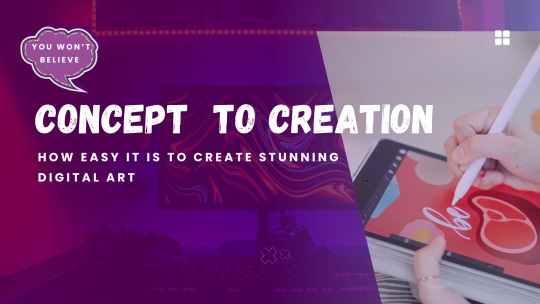#ArtCreationTips
Explore tagged Tumblr posts
Text
You Won’t Believe How Easy It Is to Create Stunning Digital Art: From Concept to Creation

In the digital age, the boundaries of artistic expression are constantly being pushed and redefined. Digital art, a medium that blends creativity with cutting-edge technology, has opened up new realms of possibilities for artists worldwide. If you’ve ever wondered how to create stunning digital masterpieces, this blog will take you on a journey from the initial concept to the final creation. Get ready to unlock the secrets of digital art and elevate your artistic skills!
The Digital Art Revolution
Digital art encompasses a wide range of creative expressions, from illustrations and graphic designs to 3D models and interactive installations. This art form leverages software, hardware, and digital tools to bring imaginative ideas to life. With the advent of powerful graphic tablets, sophisticated software, and online platforms, artists can now explore new techniques and reach global audiences like never before.
Conceptualizing Your Masterpiece
Finding Inspiration
Sources of Inspiration: The first step in creating digital art is to find inspiration. This can come from nature, urban landscapes, personal experiences, or even other artworks. Explore online art communities, such as Behance and ArtStation, for fresh ideas and trends.
Mood Boards: Create a mood board to collate your thoughts and visual references. Use platforms like Pinterest to gather images, color palettes, and textures that resonate with your vision.
Sketching Your Ideas
Digital Sketching Tools: Use sketching software like Procreate, Adobe Fresco, or Sketchbook to draft your initial ideas. These tools offer a wide range of brushes and features to replicate traditional sketching.
Refining Your Concept: Start with rough sketches and gradually refine them. Focus on the composition, perspective, and key elements that will define your artwork.
Bringing Your Art to Life
Choosing the Right Software
Adobe Creative Cloud: Industry-standard tools like Photoshop, Illustrator, and After Effects offer extensive features for creating and editing digital art.
Corel Painter: Known for its realistic painting tools, Corel Painter is ideal for artists who want to mimic traditional media digitally.
Blender: For 3D artists, Blender provides a comprehensive suite for modeling, sculpting, and rendering.
Understanding Digital Techniques
Layers and Masks: Master the use of layers and masks to create complex compositions and non-destructive edits. This allows for greater flexibility and experimentation.
Brush Settings: Experiment with different brush settings to achieve various textures and effects. Custom brushes can add unique elements to your artwork.
Color and Lighting
Color Theory: Apply principles of color theory to create harmonious and striking color schemes. Use tools like Adobe Color to experiment with different palettes.
Lighting Effects: Understand the role of lighting in digital art. Use highlights and shadows to add depth and dimension to your work.
Polishing Your Creation
Adding Details
Fine-Tuning: Pay attention to small details that can enhance the overall impact of your artwork. This includes adding textures, refining edges, and ensuring consistency in lighting.
Special Effects: Incorporate special effects like glows, blurs, and gradients to add a professional touch.
Final Adjustments
Feedback and Critique: Share your work with peers or online communities for constructive feedback. Use this input to make final adjustments and improvements.
Resolution and Format: Ensure your artwork is in the appropriate resolution and format for its intended use, whether it's for online display, printing, or animation.
Showcasing Your Art
Building an Online Presence
Portfolio Websites: Create a professional portfolio on platforms like Behance, Dribbble, or your own website to showcase your work.
Social Media: Use social media channels like Instagram, Twitter, and TikTok to reach a wider audience. Engage with followers and participate in digital art challenges to increase visibility.
Selling Your Art
Prints and Merchandise: Turn your digital art into prints and merchandise through platforms like Society6, Redbubble, and Etsy.
Commissions and Collaborations: Offer commission services and collaborate with other artists and brands to expand your creative horizons.
Conclusion
Digital art is a dynamic and ever-evolving field that offers endless opportunities for artistic expression. By understanding the process from concept to creation, you can harness the power of digital tools to create awe-inspiring artwork. Whether you’re a seasoned artist or a beginner, the secrets of digital art are now at your fingertips. Start creating today and join the digital art revolution!
Stay tuned for more tips and tutorials on mastering the art of digital creation. Your next masterpiece is just a click away!
#DigitalArt#ArtCreation#CreativeProcess#ArtConcept#DigitalDesign#ArtTutorial#ArtTips#CreativeInspiration#ArtTechniques#DigitalPainting#GraphicDesign#ArtSkills#CreativeJourney#ArtInnovation#EasyArt#ArtAndTech#DigitalArtists#ArtTools#DesignProcess#ArtCreationTips
0 notes